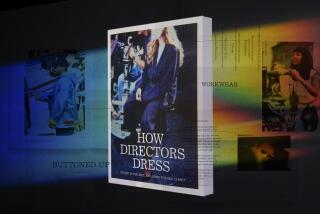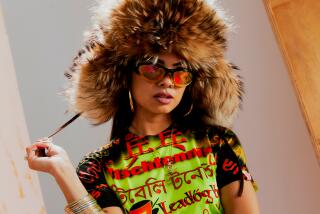It’s in the Jeans
- Share via
“My style has undoubtedly been influenced by the English team of Clacton & Frinton,” raved actor John Malkovich. “Sublimely styled suits,” purred Details. In the final days of Clacton & Frinton’s blowout clearance sale, only a few garments remained to back up these testimonials--among them a pair of subtle polka dot pajamas, a Hindu godhead halter top and a short-sleeve rayon shirt with the bittersweet message of “bonjour,” “j’espere” and “pourquoi pas?”
For 18 years, London emigres Michael and Hilary Anderson designed, manufactured and sold clothing inspired by Paramount wardrobe director Edith Head and Hitchcock’s “Dial M for Murder.” Their ideal: the scrupulously tailored Brit as seen through the rosy prism of the ‘40s studio system. It proved to be a tough sell, though, in 1990s Los Angeles. Later this year, the couple will team up with a designer from Patagonia to launch an outdoorsy-oriented shop in Santa Barbara.
The day before closing the Robertson Boulevard boutique named for an English seaside resort, his blue eyes a bit wistful beneath a mop of graying red hair, Michael Anderson delivered a Clacton & Frinton elegy--in effect, an indictment of local fashion, with Levi Strauss et al as chief defendants. “I hate jeans,” Anderson begins. “Denim is basically uncomfortable. Everyone’s in a trippy phase or state of denial about the discomfort of jeans.” On a recent evening, he espied two women in a restaurant, quite well groomed but wearing jeans. “What goes through their heads?” he asks. “Please don’t notice me in my jeans! Please don’t judge me!”
This relaxed cultural dress code, Anderson says, is to blame for the denim-and-Gap-T fog. “Once society doesn’t demand dress for special occasions, people don’t know how to get dressed. Mostly people want--I don’t know what they want--but they subscribe to this ultra-casual worn-out look. You can’t be underdressed for just about any event because everyone’s wearing sandals, shorts and a T-shirt,” Anderson says, paradoxically outfitted in sandals, shorts and a short-sleeve--though not T--shirt himself. “There’s still the idea that wearing jeans and a T-shirt is somehow nonconformist. It’s a ridiculous notion when everybody wears it!”
California, the clothier sighs, once boasted a distinctive style. You’d see men wearing two-tone jackets and shoes, splashes of bright color lapping against the sunshine, not this drab proliferation of tan. “The typical fashion victim today is monochromatic,” says Anderson. “All of the stores are color-coordinated in beiges and khakis, and a lot of them look dreary.” He pauses, and cannot help but smile. “Of course, a lot of them are still in business.”






